1. General Description
KenWood 72x
TrueX CD-Rom - Page 1
Related Companies:
 Zen Research N.V. is a privately held IP license company that produces high
performance CD-ROM and DVD optical drive designs. Zen has an affiliate
in Tel Aviv, Israel that boasts a large multi-disciplinary research and development
team. Zen's United States affiliate is headquartered in Cupertino, CA.
Zen Research N.V. is a privately held IP license company that produces high
performance CD-ROM and DVD optical drive designs. Zen has an affiliate
in Tel Aviv, Israel that boasts a large multi-disciplinary research and development
team. Zen's United States affiliate is headquartered in Cupertino, CA.
 Kenwood
Technologies (U.S.A.) which is located in San Jose, California. was created
by Kenwood Corporation in 1997.
Kenwood
Technologies (U.S.A.) which is located in San Jose, California. was created
by Kenwood Corporation in 1997.
What is Zen  technology?
technology?
Zen TrueX technology is a component set that enables optical drive manufacturers
to produce extremely fast CD and DVD drives that deliver sustained transfer
rates. Drives employing the TrueX component set read industry-standard disc
media and utilize standard CPU interfaces. TrueX component sets include optics,
detection devices and high speed ASICs. Drives made with TrueX technology illuminate
multiple tracks simultaneously, read them in parallel, and process the data
through a custom ASIC. This technology is compatible with all existing CD and
DVD formats and standards. KenWood drives are the only one for now which include
the Zen's TrueX technology.
History:
Performance improvements in optical drive technology have historically been
implemented by increasing the rotation speed of the disc and through CAV (Constant
Angular Velocity). Zen believes that these methods are no longer able to deliver
more than very small incremental performance gains. Optical disc drives with
real, average data transfer rates starting at 40X and beyond are possible using
a new technique based on Zen Research's TrueX technology. This technology promises
many benefits such as constant transfer rates, more disc-tolerant rotation speeds,
and compatibility with CDROM, DVD-ROM, CD Recordable, DVD Recordable, CD re-writable,
and DVD re-writable media.
How current CD-ROM and DVD-ROM work?
Today's most CD-ROM and DVD-ROM disc drives use a single highly concentrated
laser beam to read the digital signal that is encoded onto tracks of an optical
disc (CD or DVD). The single laser beam is directed at a single track of information,
which forms a continuous spiral on the disc that begins at the disc center and
spirals outward towards the outer edge. Variations (in data pit length) on the
disc surface cause variations in the reflected laser beam, which are detected
by an optical sensor.
The disc drive rotates the disc and the tracks run under the laser beam. The
drive system has an optical servo control that allows the laser to exactly focus
and follow the spiral path of the pits and lands, to stay focused on the "track".
The laser is reflected at different intensities (one for pit and one for land),
for different amounts of time (the length of a pit or land) as it passes over
the spiral track. The reflected laser light is directed to a light sensitive
detector that turns the light variations into a stream of serial data, representing
the pattern of pits and lands on the disc. This data stream is amplified and
sent to a microprocessor for interpretation. The laser, lenses to focus the
beam, a mirror to point the reflected beam and the light sensitive detector,
combined are known as an "optical pick-up".
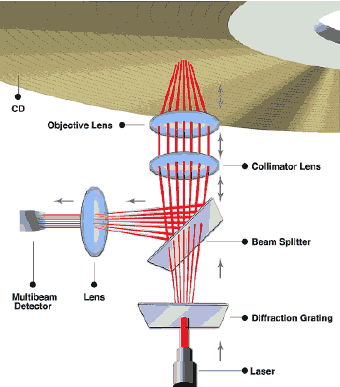 How
TrueX technology works?
How
TrueX technology works?
The Multiple Beam approach to illuminating and detecting multiple tracks
(see figure at left) uses a diffracted laser beam in conjunction with a multiple
beam detector array. The laser light from a conventional laser diode is sent
through a diffraction grating, which splits the beam into seven discrete beams,
spaced evenly to illuminate seven tracks. The seven beams pass through
a beam splitting (two way) mirror to the objective lens and onto the surface
of the disc. Focus and tracking are accomplished with conventional detection
elements on the central beam. 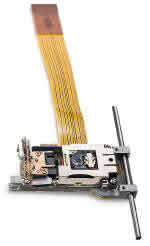 Three
beams on either side of the center beam are readable by a Multibeam detector
array as long as the center beam is on track and in focus.
Three
beams on either side of the center beam are readable by a Multibeam detector
array as long as the center beam is on track and in focus.
The reflected beams return from the disc via the same path and are directed
to the multiple beam detector array by the reflective surface of the beam splitter
(two way) mirror. The detector contains seven discrete detectors spaced to align
with seven reflected tracks. Note that a standard single beam pick up is very
similar. In a single beam pick-up, the diffraction grating would be removed
and the detector would have a single data detection point.
What are Zen plans for near future?
Zen is currently developing a 25X level of performance for DVD (with Sanyo,
one of the top three optical pick-up providers, on a Multibeam pick-up for DVD)
and hopes also deliver higher levels of performance in future:
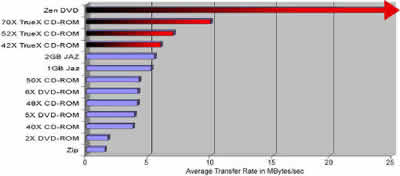
Zen has also planed a series of TrueX designs to provide increased performance
over competitors for optical storage in the next years:
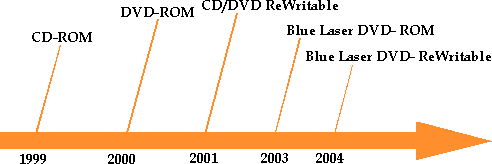
2. Installation
KenWood 72x
TrueX CD-Rom - Page 2
Package :
The retail version that came at our offices contained the drive itself,
a quick installation guide, an audio cable, four screws and an IDE cable. Below
there is a picture of the KenWood 72x TrueX CD-Rom:
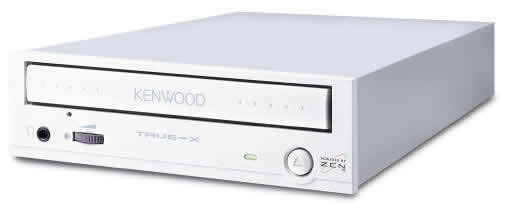
|
Specifications
|
KenWood 72x TrueX (internal)
|
|
Disc Readable
|
- CD-ROM Mode 1 and Mode 2
- CD-R
- CD-RW
- CD-Extra
- CD-DA Audio
- Photo CD (Single- and Multi-Session)
- CD-I/FMV
- Video CD
- CD-ROM-XA
- CD Extra
|
|
Interface
|
EIDE/ATAPI
|
|
Performance
|
|
Data Transfer Rate
|
|
|
Burst
|
- 16.6 MB/sec. (PIO Mode 4 and
DMA Mode 2)
- 33 MB/sec. (Ultra DMA)
|
|
Read
|
6,750 to 10,800 KB/sec
|
|
Access Time
|
Less than 100ms (typical)
|
|
Data Buffer
|
2,048KB
|
|
Front Panel
|
|
Eject
|
Auto eject; Emergency eject
|
|
Disc Loading
|
Tray, auto load/auto eject
|
|
Headphone Jack
|
Stereo mini Jack
|
|
Dimensions and Weight
|
|
Dimensions(WxHxD)
|
14.9 x 4.3 x 20cm (5.9 x 1.7 x 7.9in)
|
|
Weight
|
2.05lbs (.93kg)
|
|
Reliability
|
|
MTBF
|
50,000POH at 25% duty cycle
|
|
Warranty
|
1 year
|
Installation:
Installing the KenWood 72x TrueX CD-Rom was an easy process. KenWood suggests
putting the drive as Master in any IDE channel, so we installed it as Master
into the Second IDE channel. After booting, the CD-Rom identified itself as
KenWood UCR-421 into both the BIOS & Windows 98 SE. Afterwards, we unchecked
the auto-insert notification.
KenWood 72x TrueX CD-Rom was a January 2000 model with v2.08 firmware revision.
Our lookout at the KenWood's US website revealed a new firmware revision (v2.17),
which we immediately downloaded and updated the drive with it. This version
added support for UDMA and improved readability with CDRW discs. If you plan
to update your KenWood drive under NT, avoid it, since many users reported
problems after trying it. Instead go on if you run Win9x. After we updated
the firmware and enabled the UDMA setting in Win98SE, all was set for the
benchmark party to begin! We also had the change to get a second KenWood 72x
TrueX CD-Rom unit for double checking benchmark results... ;)
Test Machine #1:
ABIT BH6
Celeron 300A over clocked to 464 MHz
164 MB SDRAM PC 100
WD 18GB UDMA 66
Quantum Fireball EX 6.4 GB UDMA
DAWI 2975 - PCI (ULTRA) SCSI Host Adapter
Asus 3400 TNT
MS Windows 98SE
KenWood 72x firmware v2.17
Plextor UltraPlex 40max firmware v1.03
Teac 540E firmware v3.0A
Sanyo CRD-Bp2 firmware v2.17
Sanyo CRD-Bp900 firmware v3.20
Test Machine #2:
Celeron 433 with 440LX motherboard
64MB ram
Quantum Fireball 6,5 GB HD
MS Windows 98SE
PleXWriter PX-W8220 firmware v1.04
Plextor UltraPlex 40xmax firmware v1.1
Kenwood TrueX 72x firmware v2.12G
Alfreey 50x firmware v4.1
3. Data Tests: (Pressed CDs)
KenWood 72x TrueX
CD-Rom - Page 3
Data Tests: (Pressed
CDs)
Test Method:
We used CD WinBench 99 v1.1 benchmarking software and compared KenWood 72x
TrueX CD-Rom with various others CD-Roms and DVD-Rom. We also used CD Speed
99 v0.66 to check performance of drive with pressed CDs. For that test we used
WinBench 99 v1.1 and PlexTools v1.04 original CDs.
- CD WinBench 99 v1.1 results:
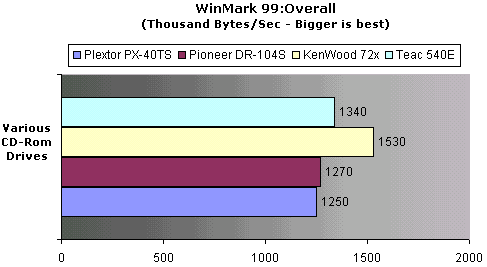
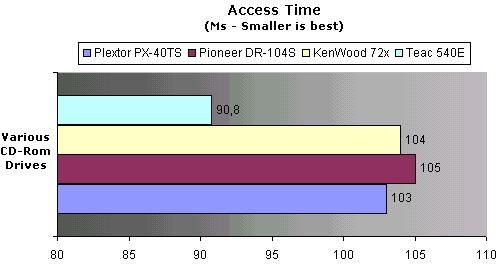
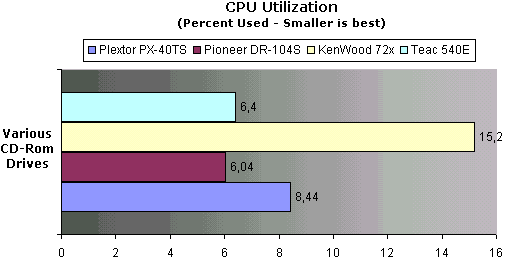
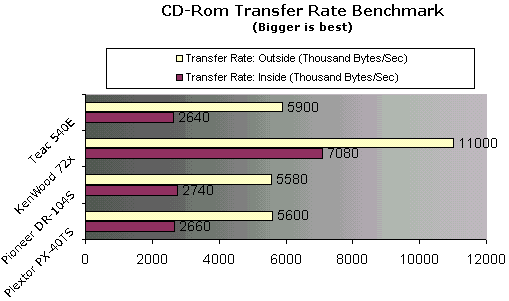
- CD Speed 99 v0.66 results:
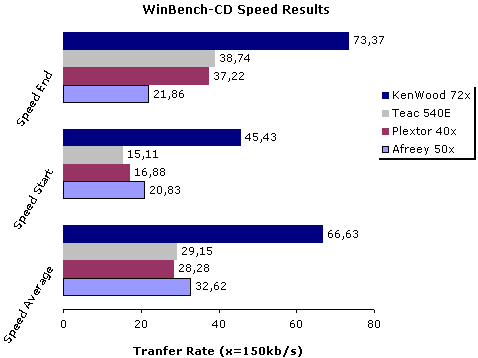
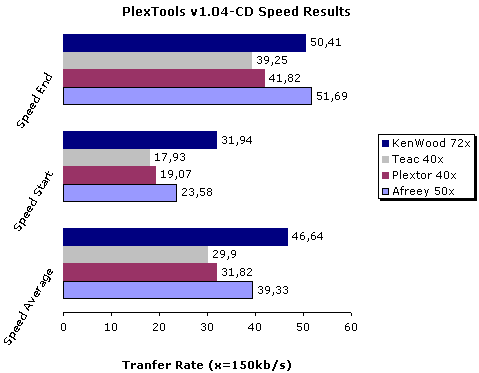
Verdict of data(pressedCDs) tests:
The KenWood 72x TrueX CD-Rom gives what it promises when it reads pressed
CDs. Ultimate Speed! It is simply the fastest CD-Rom around when using it for
reading pressed CDs outperforming 40x and 50x CD-Roms by a 51% (average) into
WinBech99-CD Speed test and by a 15.67% (average) into Plextools-CD Speed test.
The difference between the two pressed CDs results can be explained since the
scanning velocity of the WinBench disc is higher (1,3m/sec=standard) than the
scanning velocity of the PlexTools disc (1,2m/sec). If the track pitch is tighter
then the scanning velocity is lower and the disc is read faster (only applies
to (P-)CAV drives.
In the WinBench 99 benchmark test again took the first place in almost all
tests. It reached a transfer rate of 11mb/s and 7mb/s into outside and inside
of disc, which is 48.24% (average) above its competitors. It's seek time (104ms)
is very good and stays on with the competitors. CPU usage however is high (15,2%)
but then again it is an IDE CD-Rom, which in generally has much greater CPU
usage than SCSI devices.
4. Data Tests: (74min CDs)
KenWood 72x
TrueX CD-Rom - Page 4
Data Tests: (74min
CDs)
Test Method:
We made a DataCD with Nero 5.0 and made several copies into several different
media at various write speeds (4x, 8x, 12x) using various CDR-W drives in order
to test the compatibility with CD media of the KenWood 72x TrueX CD-Rom.
- CD Media 74min tests (used Sanyo CRD-BP2 CDR-W drive):
We made copies of the same Data CD with different write speeds (4x, 8x,
12x) and then we used the CD Speed 99 v0.66 to measure the performance of the
drive with the different media. Notice when you read the graphs, to check both
the three tests results (start, end, average) since they give the most complete
view of each media performance. Most users however, will prefer just to read
only the average speed results. ;)
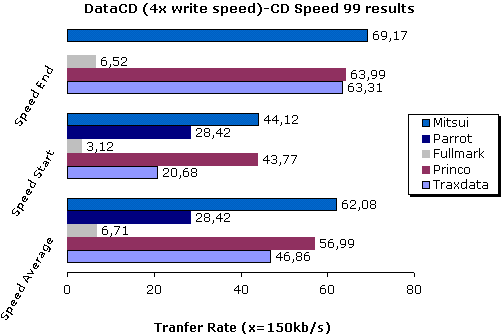
As you can notice the drive does not like at all the Parrot media, since it
refuses to complete the test and thus returns back an error message. Also notice
that the Fullmark brand also gives very low reading speed results. The Traxdata,
Princo and the Mitsui media worked very well but they also have a performance
gap between them. The Mitsui media seems to work better than other CD media
written at 4x.
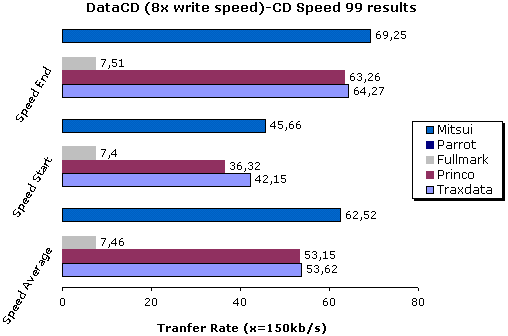
From the above graph we see that again the Mitsui media works best with the
KenWood 72x TrueX CD-Rom and gives an average performance of 62.52x reading
speed. The Princo, the Traxdata media also work good and they give an average
performance of 53x reading speed. The KenWood 72x TrueX drive refused again
to read the Parrot media and with the Fullmark media gave very bad performance
(7.46x average).
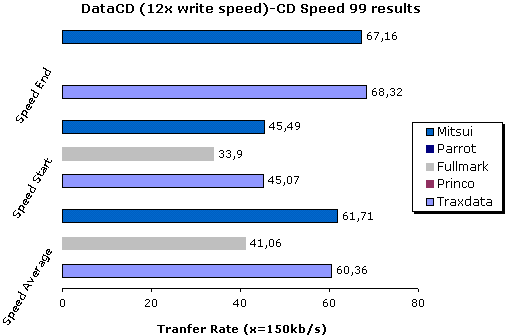
The above graph shows quite interesting stuff... The KenWood 72x TrueX CD-Rom
refused to read the Parrot and the Princo media written at 12x and failed to
complete the tests with the Fullmark media (again written at 12x). The Mitsui
and the Traxdata media worked very well and reached an average speed of 60x-61x.
- CD Media 74min tests (used Plextor PX-W8220):

From the above graph we can see that the Ricoh, Basf and the Maxell media
works good with the drive, but that's not true for the Ritek media, which produced
some poor results.
Total Results from 74min Media:
The KenWood 72x TrueX CD-Rom seems to work better with the gold dye media
(TraxData and Mitsui), less good with the Princo media and even worse with the
blue dye (Fullmark, Parrot) media. This is defiantly the weakest point of the
drive and KenWood should try to improve drive's reading performance with the
blue dye media.
5. Data Tests: (80min and RW CDs)
KenWood 72x
TrueX CD-Rom - Page 5
Data Tests:
(80min and RW CDs)
- 80min tests (used PleXWriter PX-W8220):
The KenWood 72x TrueX CD-Rom also had problems with the 80min CDs written
in mode2. We also compared it's performance with the Afreey 50x and Plextor
40x CD-Roms:

The above graph shows that with the drive refused to finish the test. Other
CD-Roms (Alfreey and Plextor) don't have any problem reading LeadData 80min
CDs.

The above graph shows that this time KenWood 72x TrueX completed the test
but gave back mediocre performance (7.62x average), where the other CD-Roms
didn't have any problem reading the FujiFilm 80min CD.
- CDR-W tests (used Sanyo CRD-BP2):
The drive refused to read the two RW CDs, we wrote at 4x recording speed
with Nero 5.0. Both CDs were tested in Plextor 40x, Teac40x, Sanyo CRD-Bp2
and Sanyo CRD-BP900P and were read fine.
Verdict of CDR Media Tests:
The KenWood 72x TrueX CDR media tests gave different results from pressed
CD tests. As it seems KenWood 72x had troubles reading CDR Media written at
high speeds (above 8x) when you are using low-quality media (Ritek, Maxell,
Parrot). In order to be sure that there was not any problem with media we
used same written media into other CD-Roms (Plextor40, Teac40x, Alfreey50x),
which read the CDs without any problem. Notice that in some cases the KenWood
72x TrueX refused to read written CDs (like Parrot media?)
When we used good quality media (Mitsui, Princo, Traxdata, BASF, Ricoh)
the results were very good just like pressed CDs. Especially KenWood
72x TrueX CD-Rom with the Mitsui media gave superb performance. The Kenwood
reads Mode 2 discs also very poorly (LeadData80 and Fuji80 were both mode
2 discs). Last, we did not manage to check RW reading speeds since the drive
refused to read two different RW media, which was working with other CD-Roms
and CDR-W, drives.
As KenWood tech support said: "...Our drive uses 1 laser source which
is split into 7 beams, the total laser power is higher then a single beam drive,
but still a single beam in our drive is 1/7th the total power. This means that
each of our seven beams is lower in power then a single beam drive. This is
the reason it's harder for the 72X drive to read fast recorded disks (CDR)...".
We think that it should not matter at which speed a disc is written since recorders
adjust the laser power depending on the media surface and recording speed..."
6. DAE Tests (Audio pressed CDs)
KenWood 72x
TrueX CD-Rom - Page 6
DAE Tests (Audio
pressed CDs):
Test Method:
We used CD DAE 99 v0.2 with AudioCDs in order to check DAE performance of
the KenWood drive and we compared it with other CD-Roms:
- CD DAE 99 v0.2 results:
The KenWood 72x TrueX dae performance with pressed CDs is not that good
since it failed to produce error free wavs in CD DAE 99 v0.2 test. Even the
error percentage it very small (2396 errors=0.00% of total CD space) we feel
that the drive should performed better and not produce any error as it's competitors
did:

Various Rippers Results:
Test Method: We used the EAC v0.9 pre beta 5 to test the audio capabilities.
EAC reported that the drive was capable of producing accurate stream
and it also reported "caching on". Tests were made for comparing "Burst"
vs "Secure Stream with caching" mode.
Tested CD: The Chemical Brothers "Dig Your Own Hole"
- Track : 1, 5, 11
Comparing Method:
- Ripped Tracks 1, 5, 10 of the CD with EAC (Secure & Burst mode).
- Edited all wavs with Hedit v2.0.04 and located the 2 following bytes (chosen
randomly)
- Removed all previous bytes and saved.
- Then in a Dos window compared them using: FC /b x.wav y.wav
Programs Settings:
EAC v0.9b: Burst
& Secure Mode / Rip Speed Default / Allow speed reduction / Error correction
medium
|
Program
|
Average Speed / CPU Usage
|
Listening Quality
|
|
1 Track
|
5 Track
|
11 Track
|
|
EAC v0.9b (burst)
|
25.3x / 50%
|
38.7x / 70%
|
23.2x / 49%
|
No clicks. No sec lost. Seemed ok!
|
|
EAC v0.9b (secure)
|
7.0x / 15%
|
9.2x /22.0%
|
9.9x / 23.0%
|
No clicks. No sec lost. Seemed ok!
|
|
Comparing Results
|
| |
EAC v0.9 (burst)
|
|
|
1 Track
|
5 Track
|
10 Track
|
|
|
|
|
EAC v0.9b (secure)
|
same
|
same
|
same
|
|
|
|
Verdict of DAE Results:
The KenWood's 72x TrueX CD-Rom DAE performance with pressed AudioCDs is
good. Using CD DAE 99, drive reached 46x average DAE speed, which is very good
(if not the fastest around). Using EAC, we managed to get even up to 45-50x
DAE speed! This makes KenWood 72x TrueX king of DAE speed on pressed CDs leaving
behind well-known manufacturers (Plextor) in case you do not care about possible
errors in wavs.
The worst point into DAE performance is that you cannot adjust ripping speed
since the drive does not support it! We hope that KenWood will add this feature
into the next firmware revision since else ways you might face some problems
with scratched CDs...
7. DAE Tests (CD media)
KenWood 72x
TrueX CD-Rom- Page 7
DAE Tests (CD
media)
Test Method:
We made several copies with Feurio v1.32 written at 12x (used the Sanyo
CRD-BP2 CDR-W drive) in order to check the DAE performance of the drive. We
measured ripping speeds with CD DAE 99 v0.2 and compared it with other CD-Roms.
CD DAE 99 v0.2 results
- Princo 12x 74min AudioCD (used Sanyo CRD-Bp2)
The KenWood 72x TrueX CD-Rom had a hard time to read the CD and finally
the test was aborted. We made several attempts but we always got "Read
error code (FD2800)" error message. That's why no KenWood results are appear
in the following graph:
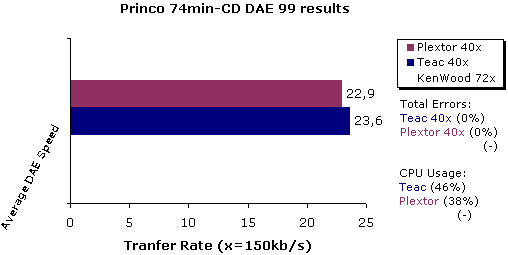
- Maxell 74min 8x AudioCD (used Sanyo CRD-Bp2)
This time KenWood read the CD and performed quite well. However, it failed
to produce 100% accurate wavs. It produced 0.36% of total CD errors where both
Plextor 40x and Teac 40 did not produced any:
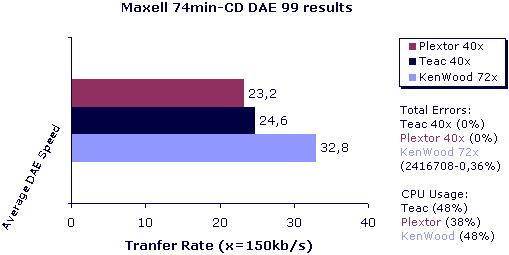
- FujiFilm 8x 74min AudioCD (used Sanyo CRD-Bp2):
The KenWood 72x TrueX CD-Rom did not have any problems reading the Fuji
Film media. As in other cases, it failed to produce 100% accurate wavs but it
gave back a smaller error rate (0.01%) than with Maxell 74min Media:
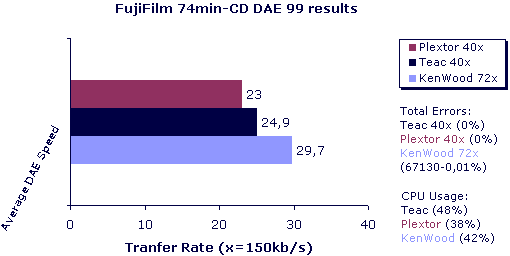
Verdict of CD Media DAE Results:
The KenWood's 72x TrueX CD-Rom DAE performance with written CD media AudioCDs
is not very good. The drive fails to produce accurate wavs and even sometime
fails to read the written CD! (Princo 12x media). Other competitors (Plextor
40x and Teac 40x) do not have any problem reading all CDs and producing accurate
wavs.
8. Conclusion
KenWood 72x TrueX
CD-Rom- Page 8
Conclusion
|
Positive (+)
|
Negative (-)
|
|
- Great data performance on pressed CDs
- Great data performace with gold dye media
- Very quite
|
- Poor performance with blue dye media
- Problems reading RW CDs
- No MMC DAO Raw read support
- High price
|
The KenWood 72x TrueX CD-Rom supposed to be the king of CD-Roms and dominate
the title of "fastest CD-Rom on planet". However, reality is not exactly,
as KenWood would expect...The drive performs very well with pressed CDs and
outperforms any other CDRom in WinBench data test. In addition, drive performs
well with Audio pressed CDs and gives back fast but not very accurate wav files.
If your CD is not in a perfect condition, you will face problems. Also noticeable
is how quiet the drive is, since it operates only from 2700- 5100ppm when most
40x-50x CD-Roms goes up to 8000-9000ppm and produce lot of noise!
The weakest point of the drive is the compatibility problem, which we faced
with blue dye media written at various speeds. In some cases, the drive had
a hard time to read the CD (very poor performance) and in other cases, the drive
could not read the written media at all! Also the drive needs to improve it's
RW reading capability since it failed to recognize two RW CDs, which worked
without any problems, into other CD-Roms and CDR-W drive we had.
However this noticed with several brands we tested. In order to be sure that
we are not the only one who has these problems we also made the tests with second
unit, which gave back similar results. KenWood 72x TrueX also cannot reduce
DAE or DATA read speed, which makes reading scratched CDs (especially Audio)
a very difficult task. Last, it does not support MMC DAO RAW reading, which
is something most users want from their CD-Roms nowdays.